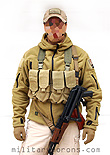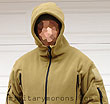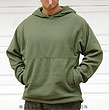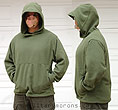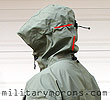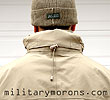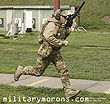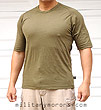Military Clothing (Non Uniform) Page
1 2
3
4 6
7 8 9
This section features Military clothing that are not uniforms/BDUs.
As a sizing reference: I'm 5'7", 155 lbs (yeah, I'm a little guy), medium build (BDU top medium/regular, BDU pant medium/short), waist 32", chest 43". Keep this in mind when you read my comments with respect to sizing, so you have an idea of how the garments featured below will fit on you. ALL garments in these pages are size Medium, unless stated otherwise.
TO VIEW FULL SIZE IMAGES: USERNAME and PASSWORD are both "mm"
TAD Gear Gen 2 (V2.0) Ranger Hoodie (this version discontinued)
| 4/7/07 - Patterned after their feature-laden tactical soft shell, the Stealth Softshell Hoodie; TAD Gear has yet again outdone themselves with the Gen 2 Ranger Hoodie. This is now by FAR, my favourite fleece jacket. I like my SPEAR and USMC Peckham fleece jackets, but I think they'll be gathering dust in the closet as the Ranger Hoodie just offers so much more. It's also a great-looking jacket to boot. TAD Gear did a smart thing, in my opinion, by incorporating the utility of the successful Stealth Softshell's features into their Ranger Hoodie. By doing that, they've set it apart from the rest - no other tactical fleece offers this many standard features. The features were carried over from both the Gen 1 and Gen 2 Stealth hoodies. The general cut and size is that of the Gen 2 hoodie, with 1" additional length in the sleeves and 1" wider in the arm pit. Here's a summary of the main features on the Ranger Hoodie:
Sizing - The Ranger Hoodie is sized like the Gen 2 Stealth Softshell - form fitting, but with enough room for an additional light insulating layer underneath. The medium size is shown here. I can wear it over the Scout Hoodie or a sweatshirt. For wind and rain protection, the Predator fits over it with room to spare (because of its low bulk and fit), as does the PCU L4 windshirt and other shells. The only additional feature I think would be nice to have are pit zips, in case you're wearing gear over the jacket and can't really open up the front for ventilation. Mobility is great; and movements are unrestricted. The Ranger Hoodie has a wide usable temperature range - it's breathable so it doesn't get stuffy, even when it's a bit warm for a fleece jacket. If the weather doesn't call for a wet-weather jacket, I predict that the Ranger Hoodie will be the go-to choice as a general use jacket as it's so dang comfortable, and has all the pockets you'd ever need to organize your stuff.
|
TAD Gear V3.0 Ranger Hoodie (discontinued)
| 2/28/08 - Updated and improved for 2008 is TAD Gear's V3.0 Ranger Hoodie. It's the follow-on to the V2.0 Ranger Hoodie shown above, which after about 10 months of use, remains my favourite fleece hoodie (until this V3.0 came out). As before, it's patterned similarly to the Stealth Softshell Hoodie, and some of the updates for the V3.0 follow those seen on the new SS V3.0 Stealth Hoodie and Jacket. TAD Gear did a smart thing, in my opinion, by incorporating the utility of the successful Stealth Softshell's features into their Ranger Hoodie. By doing that, they've set it apart from the rest - no other tactical fleece offers this many standard features. The features were carried over from both the Gen 1 and Gen 2 Stealth hoodies. The general cut and size is that of the Stealth hoodie, with 1" additional length in the sleeves and 1" wider in the arm pit. Here's a summary of the main features on the V3.0 Ranger Hoodie (some of which are unchanged from V2.0, but repeated here for completeness):
Sizing - The V3.0 Ranger Hoodie is sized the same as the V2.0 - like TAD's 2 Stealth Softshell - form fitting, but with enough room for an additional light insulating layer underneath like the Scout Hoodie or a sweatshirt. I've worn the Predator and other hardshells over it for additional cold weather protection, which fits over it with room to spare (because of its low bulk and fit). Mobility is great; and movements are unrestricted. By the way, the cool patches shown in the photos are available from TAD here. Like the V2.0 Ranger Hoodie, the V3.0 has a wide usable temperature range - it's breathable so it doesn't get too stuffy, even when it's a bit warm for a fleece jacket. As I predicted, if the weather doesn't call for a wet-weather jacket or soft shell, the Ranger Hoodie has become one of my favourite go-to choices as a general use jacket in cold or chilly weather because of its comfort, and all-round utility. It's even pretty good in the wet. It just keeps getting better with each version.
|
| 4/1/07 - TAD Gear's Scout Hoodie is a lightweight fleece hoodie for stand-alone use in warmer weather or layering in cooler weather. For now, it's only available in the version 3.0 Multi-Environment green. The M.E. green is the Scout has slightly more yellow in it than that of the Stealth Softshell - but it's pretty close for a different fabric from different manufacturers. Here's a summary of the features of the Scout Hoodie:
Sizing and wearing - The Scout has a generous cut but doesn't look overly baggy when worn alone over a t-shirt. I'd estimate the warmth of the Scout to be equivalent to a lightweight sweatshirt when worn alone - just right for spring or summer evenings when the sun goes down. The material is not wind-resistant (and is very breathable), so a shell is recommended if it's cold and windy. That's where it works well as an insulative layer. It's lightweight and low bulk, and I found it to be a perfect compliment to the Predator Hardshell featured below (almost like it was made for it). The thumb holes prevent the Scout sleeves from riding up when putting a shell over it. I also tried it under the PCU Level 4 Windshirt and Level 5 jacket and it didn't feel bulky or restrictive at all. Whether it's for hard outdoor use under a shell or worn at home relaxing, the Scout will work well in either setting.
|
TAD Gear Predator Hardshell Jacket V1.0
| 3/6/07 - Three years in the making, TAD Gear has finally released their Predator Hardshell Jacket. Shown here is the v1.0 which as been updated since this initial write up. Designed as a mid-weight waterproof hardshell, TAD has loaded it with features that will be familiar to those who own TAD's Stealth Softshell Hoodies with their unique 'look'. TAD Gear was one of the first pioneers of the tactical soft shell concept, by incorporating military and LE-oriented features in their soft shells not found on similar garments in the civilian market. There have been some tactical hardshells on the market for a while (the military ECWCS gore-tex suit, for example), and when designing the Predator, TAD researched many of the available hardshells on the market; from both the military and civilian/mountaineering sectors. Arc'teryx and their Alpha jacket, of course, served as an inspiration, as TAD Gear has always recognized Arc'teryx as a leader in innovation, forward-thinking design and quality in the industry. In this industry, there is no one company that has invented every new feature, and each company learns from its peers and combines common elements in existing designs with new features to make the garments uniquely theirs. With the Predator Hardshell, TAD Gear did just that. The Predator is available (for now) in a limited run of their M.E. (Multi Environment) green - and is a close match for the TAD Stealth Hoodie. Just a bit on the grayer side. The material used is a 3-layer waterproof, breathable fabric with DWR - essentially equivalent to Gore-tex. TAD is using the leading industrial textile sources for many of their hardshell and softshell fabrics. They custom order their fabrics from the same companies that produce the textiles used by the top mountain brands such as Patagonia. Here's a summary of the features on the Predator Hardshell:
Sizing - When I first received the Predator, one thing I noticed was that it was roomier than the Arcteryx Alpha and other softshells from TAD. The medium size I have was in between a medium and a large, I reckoned. I asked Patrick at TAD about the sizing, and he explained: "We cut the hardshell roomier than most to accommodate bulky winter layers. We compared about 6 different hardshells from all leading mountain brands as well as the ECWCS. Ours was not the roomiest, but I felt the extra bit of room allowed for a much freer range of movement with the thickest 300 weight fleece mid layer and base layers underneath. I also tried the initial prototype shells on with a 200 weight polartec, plus a LE type IIIA body armour underneath. I actually reduced some areas and increased others. These are now less wide than our original 2 prototypes, but longer in sleeve and under arm hole for the best full arm rotation even with layers. The shell if selected for the correct body size should allow a full overhead press with no exposed wrist at the cuffs. Also, if going totally prone and arms positioned to fire down range, the cuffs should be long enough to avoid creep as well. Our hard shells should fit 90% of average body types." I tried the Predator over a number of different mid layers and also with my SPEAR and TAD Gear Ranger hoodie fleece jacket. Both the SPEAR and Ranger fleece jackets work perfectly with the Predator - both in length and sizing; although the SPEAR is bulkier than the Ranger. I should mention that while the medium Predator is roomier, it's not as long in the sleeves or torso as a 'large' size jacket would be - those proportions are still optimized for a a size 'medium' person, so you should purchase your actual size. The mobility-cut arms accomodate the bulky fleece layer underneath without any problem. If you're looking for a full-featured tactical hardshell at a reasonable price, the Predator would be a good choice.
|
TAD Gear Raptor Hardshell Jacket
| 1/6/09 - TAD Gear's newest hardshell offering, the Raptor ProLite Hardshell Jacket, is the lighter weight version of their popular Predator Hardshell, currently up to version 3.0. It features the newest 3-layer waterproof breathable fabric from GE's eVent Professional Line Division. The Raptor reduces bulk with the lighter weight ripstop eVent shell, eliminates the loops swatches of the Predator on the sleeves for even less mass, allowing for easier compression for packing, and overall felt weight on the user. It's designed as a true lighter weight alpine shell for serious backpacking and mountaineering. It's not an ultralight shell, but is a great balance of weight savings and durability. The Raptor ProLite Hardshell was designed as a lightweight hard shell suitable for anyone working in the field. While the Raptor was targeted more at the civilian user, it incorporates elements from TAD's tactical designs such as pocket placement and other unique features that will work equally well for the guide, traveler, or the city dweller needing protection against the rain and wind. Even so, customers in the combat arena have been ordering the Raptor to serve as their main hard shell, but wanted to be able to pack it when not needed. The Raptor is constructed with a strategic blend of field proven traditional stitching methods and Bemis "welded" elements.
Material - The Raptor is made from the newest GE Professional Line of eVent 3-layer waterproof/breathable ripstop fabrics. Every fabric manufacturer claims that their fabric is the best, so it's no surprise that the eVent family of fabrics claim to be the highest performance 3 layers on the planet. According to TAD's website, "GE's event Professional Division pushes the envelope even further with a line which is created specifically for the hardest use environments and individuals. Developed specifically for combat and law enforcement, the eVent Professional Line is the longest wearing, most breathable, waterproof 3 layer fabrics bar none. Using advanced ePTFE membrane laminates, eVent out breaths any other high end PTFE laminate currently available. There is NO more advanced 3 layer waterproof breathable fabric on the market." So what makes eVent different from Goretex or other WP/B fabrics? Here's how eVent explains it (this is from their product information sheet):
So, in other words, eVent claims to be more efficient at allowing sweat to escape than other membranes by eliminating the PU layer normally laminated to the ePTFE membrane to protect it from performance degradation from comtaminants like body oils. Instead, the eVent ePTFE membrane itself is treated at the molecular level to protect it, retaining the open-pore structure, and allowing moisture a more direct path to vent to the outside. Does it work better? The proof is in the pudding, so they say, and while researching this writeup, the general impression I get from reading other outdoor reviews of garments using eVent is 'yes'; it's the most breathable waterproof material on the market at the time of this writing. Even more so than Gore-Tex Paclite. REI has a pretty cool demonstration video of it showing how easily air passes through eVent compared to another WP/B fabric. The eVent fabric used for the Raptor has a subdued matte
macro finish and very fine ripstop weave. The inner facing bonded
to the eVent membrane acts with capillary action to absorb moisture
from the inside and transport it to the outside. The outside is treated
with a DWR
(Durable Water Repellant) finish which is standard on most hard shells
to cause water to bead off the surface of the jacket. This coating
wears out over time with use and will require 'renewing' when the
outer face fabric begins to 'wet out' instead of bead up water. Details
on how to care for eVent garments are on their web
page. Main Features - Here's a summary of the features on the Raptor Prolite Hardshell (size Medium shown here):
Sizing and fit - The Raptor and Predator v3.0 are the same cut. When compared to my v1.0 Predator featured above, the most noticeable difference was that the sleeves weren't as wide around. On the Predator v1.0, the sleeves had a lot of extra room in them - more than I need. The sleeves on the Raptor are much more streamlined, and don't 'billow' out like the v1.0 Predator. It's more form fitting around the shoulders as well. My size medium Raptor fits more like a 'medium' than the v1.0 Predator which was between a medium and a large. It now fits better under body armour and gear, with less excess material. There's still ample room for a fleece layer underneath; I'm still able to wear my Raptor over my Ranger hoodie without looking like the Michelin man. It'll accomodate most mid layers, especially TAD Gear's, which are cut more form fitting to eliminate excess bulk. Observations and notes - Over the past few years, I've considered the Arc'teryx Alpha Jacket to be the standard by which I compared all other hard shells. So far, it still remained at the top, as far as quality, fit, workmanship, and overall design was concerned. Everyone else was playing 'catch up'. With the Raptor, I think TAD has done that. Not only does the Raptor compare in those areas, but it also offers more standard features. As far as performance goes, the eVent fabric is completely waterproof, as expected. This eVent Prolite material is my new favourite hard shell material. It's light but doesn't feel fragile, it's matte, and doesn't feel as stiff and crinkly as other hard shells, translating into more comfort. I'm a skeptic when it comes to technology and manufacturer's claims/advertisements, but I'm very impressed with the 'breathability' of the eVent fabric. So far, it's living up to the manufacturer's claims. I've had the good fortune of having some very heavy rains over the past few weeks, and cold weather. I wore the Raptor over some of my TAD Merino wool garments like the Special Service Sweater and Praetorian Hoodie, and I was the envy of all around me (at least, I imagined I was, as I was warm and dry while others looked kinda cold and damp). I didn't even feel the need to vent with the pit zips, which I left open a crack. Now, why are there pit zips if the material is supposed to be that breathable? Because no matter how breathable a material is, you can exceed its capability to get rid of that moisture especially during intense aerobic activity. Hell, put on a cotton shirt which is 100% 'breathable', and you'll still end up soaking it with sweat and getting wet. The pit zips are there in case you need to get vent moisture and heat in the quickest way possible, short of removing the jacket or opening up the main zipper, which can let in rain. They don't get in the way, so it's good to have them there if you need them. At the range, the Raptor kept me dry in the rain, and was completely comfortable even when doing drills where we had to run or move a lot.
I compared the Raptor with other hardshells made from various materials, including the V1.0 Predator and Arc'Teryx Alpha (Gore-Tex XCR), and under all conditions (low to moderate exertion, wet and dry), I found it to be the least stuffy of all of them. The eVent fabric seems to work as advertised. The new M.E. Brown colour is not too light nor dark, and the shade goes very well with a variety of gear and other clothing. I'd say that it's the closest to SOCOM FDE (Flat Dark Earth) that I've seen a piece of clothing come to. The Raptor also packs down to a more compact size than any of my other hard shells and will easily fit in most packs and bags. Perfect for the light traveler. As far as long term durability goes, we'll just have to wait for reports to come in from hardcore users in the field. By that time, TAD should have come out with another version, knowing them. But based on my initial impression with the eVent material, it certainly feels tough enough. If you think you'll be subjecting the jacket to a lot of abrasion and wear, and want to err on the side of caution and get a hard shell with slightly heavier material, then the Predator might be the one to get. Predator or Raptor? - While some companies make updates to their models every few years, TAD Gear has a reputation for revising each model almost yearly. With each version or iteration of their clothing line, TAD Gear continues to improve upon their earlier products, add new ones, which gives the the user more choices. I appreciate having lots of choices, but sometimes you end up wondering 'which one to get?'; going back and forth between the different options. The main question that people are asking is 'What's the difference between the Raptor and the Predator?'. This year, TAD went with GE's eVent fabrics for the Predator and Raptor to reduce bulk and weight. The Predator is made from a heavier eVent fabric than the Raptor, but it's lighter than last year's Stormshield Flex fabric used in the v2.0 Predator. The Raptor is made from a lighter weight eVent fabric and the velcro swatches on the shoulders were eliminated to facilitate packability and reduce bulk for less 'tactical applications. The fit between the Predator and Raptor are virtually identical, and both repel water and breathe equally well. Without knowing the difference in long-term durability and abrasion resistance between the two different eVent fabrics, there's really little difference between the Predator and Raptor. Whichever one you get, chances are that it'll end up being your favourite hard shell.
|
Rammite Australia Merino Short Sleeve T-shirt
|
12/21/06 - Hailing from down under is Rammite Australia's Merino Layering System, shown here with more of their military items available from MissionPac. Rammite is based in Perth Western Australia and their entire operation is run inside Australia from selection of the merino wool to the final making of the garment in Perth. Some of the advantages of wool are durability, insulation for both hot and cold climates, absorbance (wicking), flame resistance (natural fibers are recommended if exposure to flame is a risk), resilience, odour and static resistance. However, I'm very cautious when it comes to wool products, as I'm one of those individuals in the minority whose skin can get irritated even by the fine fibers of Merino wool, which I mentioned in my writeup on the Arc'teryx Emissary T-shirt. There's no such thing as an 'allergy' to wool, but rather a hyper-sensitivity of some individuals to the thickness of fibers. I asked Ric from Rammite to expound on the subject, and this is what he explained: "The main quality of Rammite
is our selection of the wool we uses in our products. Most wool used
in next to skin products cannot be worn by 5 to 10% of the population.
This is due to the itch factor which is proportional to the micron
count and the comfort factor of the wool being used. The thickness
of an individual wool fibre is measured in microns and 18.5 to 19.5
is the industry standard (our fibre is 18.5 microns). There should
be no problems with comfort regarding micron count as long as it is
below 19.5 microns. With that in mind, I asked Ric to send me only one of his items, not the entire line, just in case I had trouble with it. I selected the Light Weight Short Sleeved T-shirt, available in OD, charcoal and black. The shirt was designed to be worn under webbing/body armour, so the sleeve seams are kept off the webbing/body armour pressure points on top of the shoulder (see photos below). The shirt is longer than normal, which allows the tail to be below the webbing/trouser belt to stop it riding up when used in vehicle/mounted ops with body armour on. The sleeves are also longer than normal, ending just above the crook of the elbow. I like this feature, as there's less chance of it riding up under the arms when worn under another layer. All seams are flat, as well, for comfort under gear. Rammite has good relations with the Australian special forces, which has allowed them to improve their products from lessons learnt on the ground. Upon taking the shirt out of the package (it comes in its own little wool stuff sack) and putting it on, I did feel a very slight hint of prickle, which I don't feel when wearing cotton or synthetic-based garments, and only with wool. But it wasn't close to being bad enough to deter me, so I threw it on. I wore it for about 30 hours straight right out of the packaging the first time, and it felt fine after a short while and I forgot that it was wool. While it doesn't feel as 'silky' as most other synthetic fabrics, it didn't ever get uncomfortable, nor did I break out in any rash whatsoever. The real test was when I went running. Usually, sweat, combined with anything that's irritating can make me itch while cooling down, but the shirt felt just fine, much to my relief. It dried quickly, and never felt clammy. After the first wash, it softened up more. I was pleasantly surprised and impressed. The shirt performed very well throughout a range of temperatures during every day wear and exercise. Just a quick note on sizing - I usually wear a size medium top. Rammite sent me a size large which wasn't as loose as some other size large t-shirts I have to begin with, and it shrunk maybe about 5% from brand new when I machine washed and dried it the first time. It's a perfect fit now - not tight, just right (see photos). So, bear that in mind, that you might want to purchase the next size up for a relaxed fit. Rammite Australia Merino Zip Polo - Mid Weight 3/20/07 - This is the Rammite Merino Zip Polo, Mid Weight (item at the top of this page). It's a long sleeved, mid-weight zip polo. The mid-weight material is heavier than that of the Short Sleeved T-shirt shown above, and made of the same 100% Australian Merino wool. As mentioned above, the Merino wool is softer than "traditional" wool products, but still has an inherent prickliness that may or may not be irritating, depending on how sensitive your skin is. For the majority of people who can wear and prefer wool products to synthetics, it shouldn't be a problem. I've found that after wearing it for a while, my skin seems to 'desensitize' or get used to it, but it doesn't ever feel silky smooth like the other synthetic fabrics. We've had some very weird weather lately - alternating hot and
cold weeks, so I wore the Zip Polo when the weather turned colder
instead of a sweatshirt. The 9" zipper in front allows for
some temperature control and also keeps the mock turtleneck collar
snug around the neck. I found performance as far as insulation and
wicking (when the temperature was too warm for this type of garment)
to be better than cotton, and comparable to most of my synthetics.
The Zip Polo pictured here is a size Medium, not a Large. Note that like the T-shirt above, it will shrink about 5% (my estimate) if you machine wash and dry it (like I do with all my clothing). The photos above show it after washing, and it's form fitting, but not tight whatsoever. It also has some stretch to it. It's a well-designed and constructed garment, and if you like Merino wool products, it's definitely worth considering. |
ATTENTION! PLEASE DO NOT LINK DIRECTLY TO MY IMAGES
-
IT RESULTS IN MY BANDWIDTH ALLOCATIONS BEING EXCEEDED,
AND MY PAGES GO DOWN. THANKS!
/ . PLEASE
OBSERVE AND RESPECT OUR COPYRIGHT! . /
©opyright by MilitaryMorons.com. All Rights Reserved. Reproduction, Duplication,
Distribution Strictly Prohibited.
Unless mentioned otherwise, content and images are the
property of militarymorons.com and are not in the public domain.
They are not to be used without
permission. Please Contact
me for permission to use any images or content herein.
